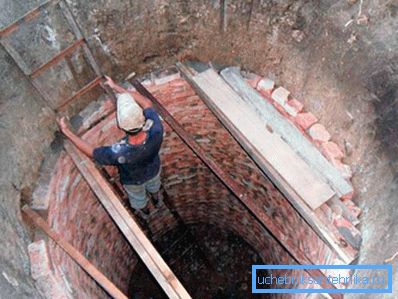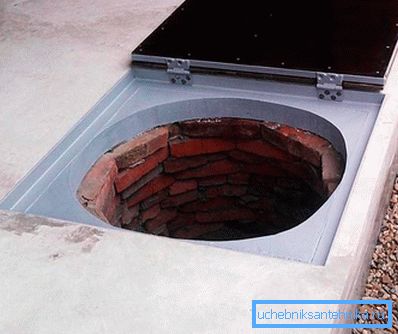Brick sewer well
The well is an integral part of the sewer. For its construction, various materials are used or installed purchased from plastic. In this article, we will consider a brick manhole, its construction and installation site.
Well site

Before construction, determine the place of installation of the well, and what function it will perform.
- To select the installation site, determine the exit of the sewer from the house If it will be a storage well, and it will have to be pumped out of the sewage by an aggregator, provide for a free access to it.
- If you build manholes, the distance between them should be at least 15 m, and the first one should be 3 m from the house’s wall, but not more than 12 m. In order not to contaminate the source of drinking water, the filter well is placed 30 m from him /
Tip! The well can be made far from the access roads, but pumping it out will cost more. In this case, you have to pay for every "extra" hose.
Well Size Calculation

To install the drain well, it is necessary to correctly calculate its volume. From this will depend on the frequency of pumping. If the well will play the role of a storage tank, make a simple calculation of its filling. One person consumes about 200 liters of water per day. Multiply this number by the number of people living in the house, and you will know the approximate amount of water drained into the well per day. Plus, add to this result the water consumption of household appliances that you have.
Making a septic tank with the sharing of bacteria for the treatment of sewage, the volume is calculated in the same way as described above, only the result obtained is multiplied by 3. The whole thing is that the bacteria process sewage in 3 days. Consequently, the volume of the well should be enough for at least 3 days of use.
When installing inspection wells, determine the size individually, so that you can freely perform the maintenance work on the pipeline. The depth of the drop wells coincides with the landscape drop. But keep in mind that deep wells are poorly cleaned, so equip them with a depth of no more than 3 m.
Well Laying

For the construction of the well, you can use any brick. The best option for such masonry would be the use of clay brick, because of its moisture resistance. A well can be constructed square, rectangular or round. You choose its shape arbitrarily, but it is easier to pump out sewage from a round well and to clean it. The wall thickness is sufficient in half a brick. Calculate in advance the required number of bricks for the entire building. Based on its size, count the number of bricks in a row. The result is multiplied by the number of rows. Having prepared all the materials, proceed to work:
- Based on the well size calculated by the volume, perform the marking of the pit on the ground. A small trench can be dug by hand with a shovel. To extract a large amount of soil, it is advisable to use the services of an excavator.
- At the bottom of the pit, install formwork to fill the foundation. Pour the foundation with a thickness of 20 cm from a solution of cement, rubble and sand. If possible, it is better to reinforce it. Leave the foundation embedded in concrete to solidify for 1 week. From time to time, water it with water to strengthen it.
- On the ready foundation you begin to lay brickwork of walls on cement mortar.
- Finished walls must be plastered with cement mortar. After the plaster has set, but is not fully dried, it is necessary to iron the walls. To do this, take the dry cement and rub it into the wet plaster.
- You make the bottom of the well depending on its purpose. For a sealed well, pour a 10 cm layer of sand and tamp it down. Pour the concrete screed on top with crushed stone. For the fortress, the bottom can be reinforced with mesh. If it will be a well with a filtering bottom, then it is not necessary to concrete it. Put a filtering layer of sand 20 cm and rubble or gravel up to 40 cm at the bottom.
- Dried plaster on the walls must be waterproofed. To do this, take hot bitumen or mastic for waterproofing and cover the entire surface of the walls.
- At the entrance to the sewer well, knock out a hole using a perforator. Also, the window for pipes could be left in advance, during the laying of bricks, if it is possible to calculate their location. After inserting the pipe, seal the gap with silicone.
- At the last stage, it remains for you to fill the ground with a gap between the walls of the well and the pit and cover the well. The overlap can be made of wooden shield, processing it with bitumen, or lay a concrete slab. In the ceiling should be a hatch for access to the well. Ventilation is required for the drain well. Therefore, install a plastic pipe with a diameter of 50 mm and a height of 600 mm into the ceiling. Put a fungus on top. Cover the edges of the floor with soil, but so that it is 10 cm higher than the ground level.

Brick well, built with his own hands ready for operation. You only need to clean it in time.
We advise you to read:
- clean the sewers in a private house with your own hands;
- how to make a cesspool in a private house with your own hands;
- installation of sewage in a private house with their own hands.
Video
See how to build a septic tank of bricks with your own hands: